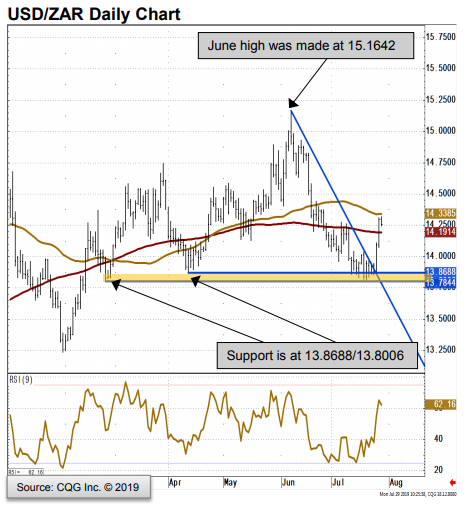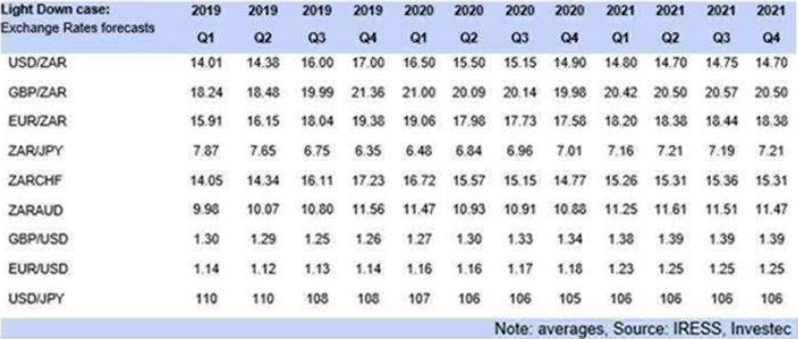South African Rand Poised for Downward Correction, says Technical Analyst, as Ratings Agencies Circle
- Written by: James Skinner
-

Image © Adobe Images
- ZAR falls as USD advances and market awaits Eskom results.
- ZAR has now topped out, eyes turn lower, says Commerzbank.
- As Investec Bank warns that 'down case' becoming more likely.
- Morgan Stanley starts to doubt ZAR outlook amid debt concerns.
The Rand ceded ground to a buoyant Dollar and Brexit-stricken Pound Sterling Tuesday as financial markets await the latest financial results from ailing power utility Eskom, although multiple analysts are growing increasingly concerned about the outlook for the South African currency.
South Africa's Rand has topped out following weeks of strong gains and is now poised for a more protracted downward correction, according to technical analysts at Commerzbank, which already looks to be underway this week.
"USD/ZAR’s sell-off from its June high at 15.1642 has taken it to support made up of the April low at 13.8688 and the late February low at 13.8006 from where it rallied last week back towards the 55 day moving average at 14.3384. A bottom formation has thus been confirmed with the June 21 high at 14.4422 being in the picture," says Axel Rudolph, a technical analyst who studies trends and momentum on the charts at Commerzbank.
Rudolph is looking for the USD/ZAR rate to extend its upward correction, implying a downward move for the Rand, up to 14.42. He's also warned the 14.5880 and 14.6795 levels are now in prospect for the days ahead given the exchange rate has marked out a "bottom formation" on the charts.
Commerzbank is looking for technical factors to carry the exchange rate higher over the coming week but traditional fundamental factors could also help the Rand lower Tuesday and over the coming days if commentary from local analysts is anything to go by.

Above Commerzbank chart of USD/ZAR rate showing technical indicators.
"Fitch has downgraded SA’s BB+ ratings outlook to negative because of fiscal deterioration due to “lower GDP growth and increased spending, including SOE support”. This now increases Fitch’s projections for the government debt-GDP ratio," says Thanda Sithole, an economist at Standard Bank. "Fitch is clearly sceptical about government implementing policy changes to improve the fiscal and growth prognoses."
Fitch Ratings, which long ago cut the South African government credit rating to 'junk' status, downgraded the outlook attached to its already-reduced rating Tuesday. It says the outlook for the BB+ rating is now negative due to additional financial support the government has had to provide Eskom, the state-owned electricity producer.
The downgraded outlook comes just days after Moody's, the last remaining major agency to still rate South African debt as 'investment grade', warned that the Eskom support package announced by finance minister Tito Mboweni last week is "credit negative".
"We now look to SA’s sovereign rating from Moody’s which still has SA rated at Baa3 with a stable outlook. The risk of a downgrade in November has undoubtedly increased," Sithole writes, in a note to clients. "We now see the rand ending the year weaker, at R14.00/$."

Above: USD/ZAR rate shown at 4-hour intervals, alongside Pound-to-Rand rate (black line, left axis).
Eskom has long struggled to keep the lights on for households and businesses due to years of underinvestment in infrastructure but the government has guaranteed more than R350bn of its debt and more recently resorted to pumping cash directly into the company.
This is adding to the budget deficit and debt-to-gdp ratio at a time when ratings agencies want to see both falling, which is why Standard Bank has lifted its year-end USD/ZAR forecast from 13.80 to 14.00, although some analyst say the Rand would fall much further than that if the rating went.
Furthermore, the government revealed plans for a partial nationalisation of the private healthcare sector this week as part of an effort to provide universal healthcare to all citizens which is free at the point of delivery. This too also promises to worsen the public finances.
"A more dovish Fed will keep high-yielding EM currencies supported. However, the fiscal trajectory of South Africa is looking more worrisome, and although we think FX is more attractive than local bonds, we are no longer sure ZAR can outperform," says Geg Teng Khoo, a strategist at Morgan Stanley.

Above: USD/ZAR rate shown at daily intervals, alongside Pound-to-Rand rate (black line, left axis).
Losing the Moody's 'investment grade' rating could hurt the Rand badly because it would force many institutional fund investors to sell their South African government bonds, which could then see lots of Rand dumped on the market as investors swap foreign capital back into their domestic currencies.
And for every additional notch below 'investment grade' the government rating falls, the more the pool of international funds able to own South African bonds will shrink, which means increasing downward pressure on the Rand.
The government said in February its budget deficit would likely come in at 4.5% of GDP for the 2019/20 year, which was too high for Moody's liking in the first place, although the latest financial support package for Eskom is threatening to send the deficit to 6% for the current year.
"As South Africa is seen to move closer to becoming a sub-investment grade country, as rated by all three of the key credit rating agencies - the probability of the lite down case increases," warns Annabel Bishop, chief economist at Investec Bank."The upwards revision of the probability attached to the lite down case has increased the risk of further weakness for the domestic currency this year and next."

Above: Investec Bank foreign exchange forecasts for 'lite down case' and 'severe down case'.
Bishop says that financial markets should already have largely priced-in the threat of South Africa losing its investment grade rating, but she's warned that the "ongoing further downgrades" alluded to by Fitch this week are not in any way reflected in the current price of the Rand.
Investec's forecasts suggest the USD/ZAR rate could rise to 17.00 by year-end and the Pound-to-Rand rate rise to 21.36 if the Moody's rating goes the next time it's reviewed in November and Bishop's 'lite down case' begins to play out.
In the absence of a credit rating downgrade this year, Bishop forecasts the USD/ZAR rate will end 2019 at 13.90, which implies a fall from Tuesday's level, and the Pound-to-Rand rate will rise from 17.32 to only to 17.46.
"With the FOMC likely to cut interest rates this week by 25bp the rand could once again track towards R14.00/USD, and indeed could break through this key resistance level in the last quarter of this year, and move into a more sustained range of R12.00/USD to R13.00/USD should SA avoid a Moody’s credit rating downgrade, although the chance of this has fallen," Bishop writes.

Above: Investec Bank scenarios for the South African Rand.
Time to move your money? Get 3-5% more currency than your bank would offer by using the services of foreign exchange specialists at RationalFX. A specialist broker can deliver you an exchange rate closer to the real market rate, thereby saving you substantial quantities of currency. Find out more here.
* Advertisement




